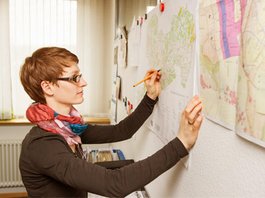Wind farm planning is a marathon effort
It takes several years, from the first site analysis to the first turn of the rotor blades.
Through the step-by-step explanation that follows, which covers site analysis to construction, you can build a picture of how the project unfolds at UKA when constructing and installing a wind turbine.
The dialogue with communities and citizens represents an ongoing, collaborative process rather than an individual measure. This ensures the necessary acceptance of the wind energy project and enables the planning to be adapted swiftly to the requirements on site.

Site analysis, wind measurement and performance audit Analysis

The key criterion in selecting a site for the wind generator is its viability in terms of windiness: how strongly and consistently does the wind blow over the plot? For example, Data from the German Meteorological Service (Deutscher Wetterdienst) provide information on this. With the aid of wind atlases we can identify whether a plot of land lies in an area with good wind viability. If this is the case, the potential areas will be inspected on a site visit. In addition, UKA relies on long-term wind measurements in order to be able to assess the commercial profitability of the wind energy project. From now on this will be checked again at each stage of the planning.
A precise site survey is carried out through the use of geo-information systems and land surveyors. In the process, UKA receives a detailed overview of the terrain’s features and characteristics. This ensures, amongst other things, that the necessary distance from inhabited areas is maintained and that conservation areas and protected parts of the countryside are not affected.
Securing sites and involving the public and community
Once suitable sites have been identified discussions take place with local residents. When it comes to wind energy projects the land is usually not sold. Instead, the rights of use required for installing and operating the wind turbines are secured for the long term. The advantage for landowners, farmers and communities: the land remains the property of the community or family and can continue to be farmed while the wind turbines are in operation.
UKA implements pool models, or citizen participation schemes, so that local residents and those who live in the planning area also benefit from “their” local wind in addition to the owners of the land occupied by the wind generators. This leads to greater acceptance of wind energy generation. With communities UKA is seeking collaboration by means of infrastructure agreements, in order to gain access to the land and paths belonging to the community within the area suitable for a wind turbine.
Wind farm configuration and network planning

On this basis UKA configures which type of turbine is best suited to the site in question. Some turbines are effective for strong coastal winds; while others are particularly suited to use inland or in low mountain ranges. UKA can draw on a wide portfolio of the most up-to-date turbine models, since the Group has concluded long-term framework agreements with leading manufacturers. For an optimal wind yield it is very important to ensure that the turbines within the wind farm are correctly positioned in relation to each other. This planning therefore already runs parallel to the site analysis and securing process. Once the wind farm has been configured, UKA enters the final stage: detailed planning of the network infrastructure. How and where the wind power can be fed into the network is likewise also considered at the initial site analysis stage.
Obtaining authorisation

UKA keeps in mind the effects on the environment throughout the entire development of the wind farm project. Investigations into this are of key importance, because no wind turbine will be approved if it has an unacceptable detrimental impact on people, flora or fauna.
The latter is checked as part of an independent avifaunal report. This type of research involves, amongst other things, charting breeding birds, bats, resting birds, migratory birds and, where applicable, other species and groups over a time period of more than one year.
Other reports are aimed at protecting people, for example by assessing the effects of noise and shadows from the turbines.
Construction process

As soon as authorisation has been granted UKA makes a start on constructing the wind farm. You can find out more about the construction process for erecting wind turbines here.
Constructing and dismantling the wind generators – no risk for landowners
Contrary to the large-scale changes to the landscape that lignite mining entails, the impact of wind generators is reversible. They are constructed, generate clean energy for two decades, are subsequently fully dismantled within a few days, including the foundations, and, ultimately, are replaced by grassland or a field that can be farmed. Landowners who work with UKA bear no risks in terms of liability or dismantling.
- What happens when wind generators are built on my property?
The wind turbines require a solid concrete foundation as well as access. During construction it is necessary to have platforms for the crane and the construction equipment. While the technology is being erected temporary access routes are often required too; these are then fully removed once the build is successfully completed. Should the development take place during a particular infructescence phase, you or your tenant (as applicable) will be compensated for the crop loss incurred for the patch of land affected. Drainage systems (land improvement) located on your land will remain intact. You can find further information on the construction process here.
- Do I bear any dismantling risks after the wind generators are decommissioned?
Landowners who work with UKA bear no risks in terms of liability or dismantling. In addition to an exemption from liability the lessor receives a dismantling guarantee for the wind turbine, its foundations and the accompanying infrastructure.
